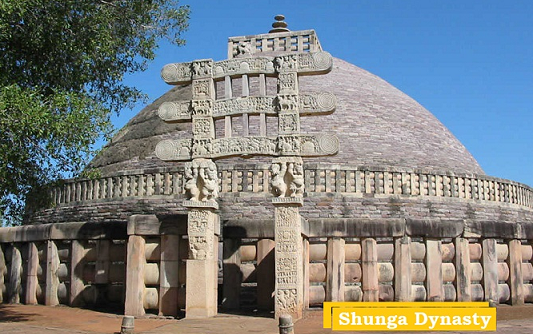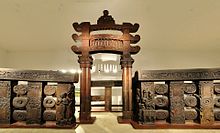
After the death of Ashoka, the empire started disintegrating, and finally the last king Brihadratha was killed by a Brahamana viceroy at Ujjain Pushyamitra Shunga in 185 BC and reigned for 36 years. Its capital was Pataliputra, but later emperors such as Bhagabhadra also held court at Besnagar (modern Vidisha) in eastern Malwa.
Pushyamitra Shunga:
- He was not happy with his king Brihadratha, who failed in containing the Yavanas and attacks from the western sides.
- Pushyamitra Shunga was also credited to repulse the two attacks of Greeks and also conquest over Vidarbha. Pushyamitra is also known to have repelled the Kalinga’s king Kharvela conquest.
- Some evidences say that Pushyamitra Shunga destroyed many stupas of Asoka. But there are also evidences that Barhut Stupa was built during the Shunga Empire only.
Agnimitra:
- Agnimitra succeeded his father Pushyamitra Shunga and reigned for a short period.
- He is the hero of Malvikagnimitram of Kalidasa in which he has been referred to as Raja.
- By the times of Agnimitra, Vidarbha had become independent of the Maurays.
Vasumitra:
- Agnimitra was succeeded by Vasumitra around 131 BC. Who succeeded Vasumitra , not much details are available. Different accounts mention the name of different kings such as Andhraka, Pulindaka, Ghosha or Vajramitra.
- The last rulers of Shunga dynasty were Bhagabhadra and Devabhuti.
Bhagabhadra:
- We know about the king Bhagabhadra by a Heliodorus pillar, which has been found in Vidisha, Madhya Pradesh near modern Besnagar.
- Heliodorus was a Greek ambassador and he dedicated this pillar to God Vasudeva (Vishnu). The Heliodorus pillar has a surmounted figure of a Garuda.
Devabhuti:
- Devabhuti was the last Shunga Ruler who was killed by his own minister Vasudeva Kanva in around 73 BC.
- Vasudeva Kanva founded the Kanva Dynasty.
Art and Architecture

- Art, education, philosophy, and other forms of learning flowered during this period including small terracotta images, larger stone sculptures, and architectural monuments such as the stupa at Bharhut, and the renowned Great Stupa at Sanchi, which was enlarged.
- Shunga rulers helped to establish the tradition of royal sponsorship of learning and art. The script used by the empire was a variant of Brahmi script and was used to write Sanskrit.
- Patanjali’s Yoga Sutras and Mahbhaṣya was composed in this period. Artistry also progressed with the rise of the Mathura art style.
- Artistry on the subcontinent also progressed with the rise of the Mathura school, which is considered the indigenous counterpart to the more Hellenistic Gandhara school of Afghanistan.
- The Dhanadeva-Ayodhya inscription records that Pushyamitra performed two Ashvamedhas (victory sacrifices) in Ayodhya.

 Home
Home Syllabus
Syllabus Contact Us
Contact Us




